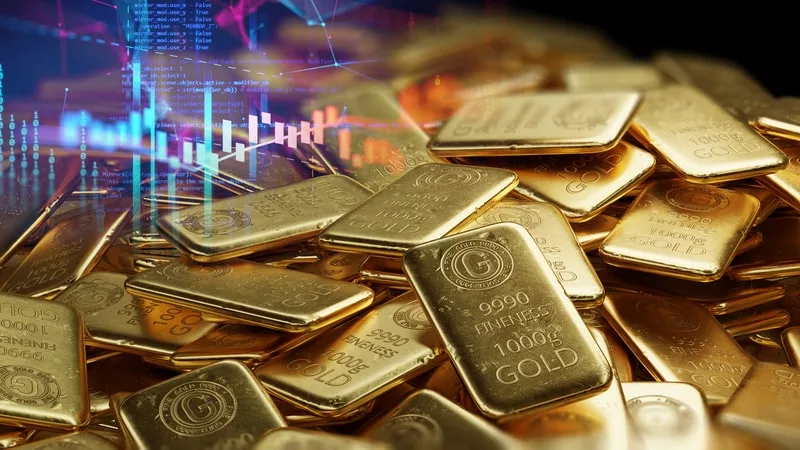Investment in Gold
Table of Contents
The Beginner’s Guide to Investment in Gold

Gold has always been seen as a valuable, sought-after material. In ancient times, gold could easily be melted and molded into coins, and its beautiful lustrous shine created fine jewelry. The high demand for gold and the hard work it requires to mine and pan for it increases its value even further. People stay fascinated with this precious metal.
It is no surprise that gold continues to be a popular investment today, especially in the form of coins and bullion boxes. If you are looking to broaden your investment portfolio, or if you are new to investing altogether, you have come to the right place. In this beginner’s guide to investing in gold, you will find all you need to know about gold and its investment potential.
Introduction to Gold
You should know all you can about a commodity before you invest in it. You are surely no stranger to gold. You probably have gold in your home, whether in the form of jewelry, dinnerware, collector’s coins, trinkets, or other items you have accumulated. You learned about the element Au on the periodic table. What else do you know?
There is more to gold than you might think. While its beauty is obvious, its value goes beyond its shine and luster. Gold has multiple uses. Gold’s elemental makeup ensures that it is uniquely suited to all kinds of utilities. As an investment, gold is considered safe and low-risk. And this is why there is no dearth of gold buying companies in the USA. Read on to learn more about gold and why you should invest in it.
What Is Gold?
Gold is a highly versatile chemical element that occurs naturally in the earth. It is usually found in rocks or as standalone nuggets in the ground. Gold is striking because of how shiny and bright it appears in its natural state, with a metallic yellow-orange hue.
Additionally, gold is resistant to corrosion and most chemical reactions, which sets it apart from many other metals and elements. It is resistant to many acids. Gold is very strong but also extremely malleable. These characteristics are what makes gold so unique and special.
Gold’s ability to be hammered, shaped, and melted down into molds gives it a wide variety of uses. While it is, of course, frequently used in making beautiful jewelry, gold also has hugely beneficial industrial applications due to its non-corrosive and conductive properties. Gold is commonly used in electronic connections and in the medical field.
History of Gold
Humankind, as a whole, discovered and made use of gold before any other metal. Like with many things throughout history, different civilizations made independent use of precious metal. Archeologists have found traces of gold in ancient caves dating back all the way to 40,000 B.C.E.
Evidence shows that civilization in what is now Eastern Europe used gold for decorative and fashionable purposes around 4000 B.C.E. In 1500 B.C.E., gold was used in the exchange of goods in Egypt. Venice created the gold Ducat in 1284, which quickly became the world’s most popular coin for centuries to come. In 1091 B.C.E., China legalized the country’s first form of gold money.
In 1803, the first US Gold Rush began when gold was discovered in North Carolina. Forty-five years later, in 1848, the California Gold Rush began when gold was found near Sacramento. This discovery and rush to find gold had an untold impact on the US westward expansion and settlement. A third Gold Rush took place in 1898 when prospectors found gold in Alaska.
Gold has a rich history. It is featured in ancient epics, encompasses the spoils of extraordinary wars, and serves as the basis for massive explorations and conquests. Today, prudent investors diversify their portfolios with the world’s most ancient and storied metal.

Different Options for Buying Gold
Now that you know that gold is the best precious metal to invest in, you need to learn about the different buying options you have. Fortunately, you no longer have to head to the mines or the river in search of gold. Modern gold investors have different options for buying gold. There are gold dealers and brokers available to help anyone get their foot in the door of gold investment. However, it is crucial to work with a legitimate, reputable dealer.
You can buy gold by weight, meaning you do not care what form it takes as long as your purchase reaches a certain weight, or you can buy gold in different forms. Your personal preference and your overall investment goals typically impact how you buy gold. However, many people choose to use all of their options when investing in gold.
Gold by Weight
Some gold investors choose to buy gold by weight units, such as ounces or grams. For these investors, the form of the gold they buy is irrelevant. They simply want to purchase a specific weight of gold. Buying gold by weight is the most affordable way to buy gold because you can buy a bulk amount of gold at once.
The standard unit of measurement for precious metals like gold is the troy ounce. If this sounds like something from the Middle Ages, that is because it is. The troy ounce was originally used in Troyes, France, but historians think it could date back to Roman times. One troy ounce equals approximately 31.1 grams or 1.097 ounces.
Most dealers will offer a lower price when you purchase a bulk weight of gold. This is especially true when you buy very large quantities of gold, but not everyone has the ability to start off their investment by spending $100,000. Always use a reputable dealer so you know you are getting a fair price per ounce.
In the case of buying gold by weight, gold bullion is usually the most suitable way to buy gold. People will buy large quantities of gold bullion coins to achieve this.
Gold by Form
Other gold investors prefer to buy gold in certain forms. Gold comes in many forms: gold bars, gold subscription boxes, jewelry, coins, and even non-physical forms like ETFs, mining stocks, and gold futures. Depending on an investor’s goals, buying gold by form might be more practical or necessary during certain purchases.
A piece of gold jewelry, for instance, will be valued based on more than its gold content. Additionally, you would not buy mining stocks by weight but by share prices. When buying gold EFTs, you would never actually handle gold during the entire transaction.
What Is the Gold Standard?
The Gold Standard is a method of valuing a country’s currency by directly linking its value with gold. Physical gold backs the value of money. Under the Gold Standard, a country’s money can be converted to and from gold easily, meaning paper currency can be redeemed for gold under this system.
The quantity of paper currency circulating was related to how much gold the central banks’ had in reserve. Under the classical Gold Standard, this system of linking the value of the currency to gold was recognized across nearly all countries internationally. In this case, different countries’ currencies were convertible at stable exchange rates.
History of the Gold Standard
Before individual Gold Standards or a universal Gold Standard was in effect, silver was the primary standard to which currency adjusted. In 1821, the UK implemented a Gold Standard in its country. In the 1870s, Germany, France, and the US adopted a monometallic Gold Standard as well.
When the first World War began, gold exports became tightly restricted across the world. People could no longer freely convert paper currency. The Gold Standard was re-established briefly but collapsed again during the Great Depression. In the US, the Gold Standard officially ended in 1933. By 1937, no country had a Gold Standard.
How the Gold Standard Works
Each country that operated by a Gold Standard kept gold reserves on hand in central banks. The currency in circulation throughout the country was linked to the amount of gold in reserve. Each unit of gold represented a fraction of the money in circulation.
For example, if an ounce of gold was valued at $500, then there should be one ounce of gold in reserve for every $500 in circulation. Most countries set legal minimums for the ratio between their gold reserve and paper currency. This prevented the gold supplies from getting too low compared to how much money was circulating.
What Are the Advantages and Disadvantages of the Gold Standard?
There have been proven advantages and disadvantages to using the Gold Standard. In the past, the Gold Standard worked well for a stable national economy. However, with today’s global economy, it is hard to fathom how the Gold Standard could possibly keep up with the economic needs of the modern technological world.
Advantages of the Gold Standard include:
- The Gold Standard stabilizes prices: Governments cannot print paper money arbitrarily and cause hyperinflation.
- The Gold Standard provides steady exchange rates: International exchange rates between countries are much simpler and stable.
- The Gold Standard is less risky: Economic crashes and recessions are less likely.
- The Gold Standard prevents outrageous debts: Governments cannot print more money at will, therefore increasing national debt.
Disadvantages of the Gold standard include:
- The value of gold fluctuates: While gold is always valuable, its value is not totally stable. Inflation and deflation rely on gold availability.
- Different countries would have the upper hand: Countries with the ability to produce lots of gold could supplement their gold reserves.
- The Gold Standard prevents economic stimuli: Governments cannot print more money during an economic recession.
- Gold operations can be harmful: Mining, refining, and storing gold has a significant environmental impact. It is extremely costly. It also harms indigenous lands.
There are arguments to be made for the Gold Standard. It offers a certain peace of mind because you know that inflation cannot get out of hand. Proponents for implementing a Gold Standard today include conservatives and economists who want to keep the government’s spending power in check.
However, when governments do not have the power to stimulate their country’s economies, consequences can be disastrous. The arguments against the Gold Standard are on par with the arguments against dismantling the Federal Reserve.
Gold Standard vs. Fiat Money
Fiat money is government-issued currency. Fiat currency is not backed by a standard. The modern US dollar, for example, is fiat currency. The value of fiat currency fluctuates on the foreign exchange market. The government that issues fiat currency backs the currency’s value on “full faith and credit” and decrees it as legal tender.
As mentioned above, the Gold Standard had currency backed by the commodity gold. Unlike fiat currency, Gold Standard currency’s value was linked to a specific physical commodity held in central reserves. Under this system, more currency cannot be printed without the appropriate amount of gold reserve to back it up.
How Gold Prices Are Determined
Twice a day every day, the ICE Benchmark Administration (IBA), which is made up of banks, an oversight committee, and chair members, publishes the London Bullion Market Association (LBMA) Gold Price.
This price is determined by the financial outlook of LBMA electronic auction rounds that occur frequently and periodically. When the anonymous auction rounds reach trade values within certain parameters, the gold price is considered fixed, and the LBMA Gold Price is set.
While the LBMA sets the gold price, it does not pull these numbers from thin air. Gold prices, like the prices for many commodities, are determined by supply and demand. Additionally, investor behavior and economic conditions affect gold prices.
Central Bank Reserves
Countries around the world have central banks that house money and valuable monetary reserves of different kinds. While a central bank will house a particular nation’s paper and minted currency, it will also house the country’s gold reserves.
Even though the world does not operate under a Gold Standard today, countries still amass gold reserves. When central banks accumulate more gold and move away from paper currencies, the price of gold tends to rise.
Value of the US Dollar
The value of the US dollar on any given day affects the price of gold. The way teachers in high school explain this is confusing, but it is actually quite simple.
Gold is dollar-denominated. This means that the price of gold is fixed in US dollars. When the LBMA Gold Price is fixed at each interval, it is announced in US dollars rather than in other national currencies. Because of this, the price of gold is inversely related to the value of the US dollar.
So, when the US dollar is performing strongly in the international economic market, the price of gold will be lower. When the US dollar is dragging and considered weaker, the price of gold will increase.
Industrial Demand and Supply
Gold has many industrial uses. Electronics manufacturers use gold in computer components and memory chips. Gold is used in medical treatments and dental fillings. Gold is used in space travel for shuttle components and circuitry. Certain types of glass production also use gold. Gold is crucial for technological advancement.
The jewelry industry requires gold in massive quantities. In fact, the jewelry industry can account for around half of the demand for gold in a given year. This is more than what the best gold bullion companies and other industries combined together demand. When demand spikes within these industries, the price of gold increases.
Inflation
Gold prices typically rise with inflation. The Federal Reserve prints more money and expands the country’s overall supply of money, which weakens the value of the US dollar. Inflation’s impact on the price of gold is similar to the US dollar’s role in gold prices, though inflation is only one factor that affects the US dollar’s power.
Investment Demand
Gold electronically traded funds have a small impact on gold prices. However, depending on how much gold an EFT represents, it can make up a large percentage of overall gold demand.
When investment demand fluctuates, the trade activity of these EFTs will show changes on the stock exchange. EFT purchasing activity can influence gold prices.
Gold Production
Gold mining is a continuously operational industry. The more gold that is produced to meet demand, the less expensive gold will be. When gold production does not meet the demand, the price of gold can skyrocket.
However, most of the earth’s easy-to-access gold has already been mined. This means that the gold being mined now and the gold that will be mined in the future will cost more to reach and will be more dangerous for miners. Therefore, gold prices will likely increase to make up for the hazards and environmental impact.

Why Gold Matters
Gold will always be valuable. While the price of gold fluctuates for many reasons listed above, there is no indication that gold will ever lose its value. Gold is as intertwined with humankind as fire. Once we discovered it, we swore never to let it go.
There is enough gold in the world to make bullion, but gold is scarce enough that not everyone can go outside and find it. It does not undergo chemical reactions except under specific circumstances. Gold does not corrode, so investments and valuables are sustainable and, essentially, eternal.
Gold As An Investment
Gold is important for investors because it offers a relatively safe and low-risk means of diversifying an investment portfolio. With so many ways to invest in gold such as buying gold subscription boxes, gold bars, ETFs, and the like, an investor has plenty of options to invest at any comfort level.
Physical gold is safe, tangible, albeit expensive, valuable to keep on hand. However, there are other affordable, intangible gold investments that average investors can access more readily. In essence, gold is a sensible, safe investment for investors of all kinds.
Additionally, as an investment, gold acts as a preservative. The US dollar constantly faces inflation, but gold hedges against the dollar’s weakening value.
Gold As a Valuable Metal
Gold is a valuable metal because of its many practical uses and its strength. It can be argued, though, that gold holds a preternatural value that cannot be quantified. Long before international currency exchanges and stock portfolios, ancient civilizations discovered an innate, intense attraction to the metal. That is never going away. This is the same reason why it is still the best precious metal to invest in.
Gold As a Safe Haven
A safe haven is somewhere you can go when things get rough. You would not normally go to your safe haven when things are going great in your normal day-to-day life, right? This is why gold is considered a safe-haven investment. It protects investors during times of economic crises, but it is less valuable during times of economic prosperity.
Gold has always been valuable throughout human history. It is not projected to ever lose its value entirely (i.e., become worthless). Therefore, investors can rely on gold in times of political strife, environmental turmoil, and economic instability.
A good investment portfolio should include safe-haven investments that lower the portfolio’s overall risk. Gold is an extremely popular portfolio diversifier because it is a safe haven investment. Should all other asset correlations fail, gold will remain valuable and safe.
Different Types of Gold Investment
If you want to begin investing in gold, you are not tied down to simply buying gold jewelry or bullion. Because of all its many forms, gold is more accessible to investors than other commodities. While jewelry and bullion are excellent investment options, there are many different types of gold investment in which you can take part.
Gold Bullions
Gold bullion is gold bars that vary in size and shape. They are made up entirely of gold metal that has been melted and molded. You have likely seen large gold brick bullion in movies or cartoons, but gold bullions come in all kinds of sizes, from big to small.
The larger the gold bullion you buy, the more valuable it is. You can purchase gold bullion as small as a quarter-ounce wafer to as large as a 400-ounce brick. When you invest in bullion, you must be sure to purchase it only from a reputable dealer. Additionally, you will need a place to store it. Large bullion bricks can quickly become expensive to store.
Gold Coins
Investing in gold coins enjoys equal popularity as bullion. There are two types of gold coins you can purchase: gold bullion coins and gold numismatic coins. Each type of coin has a different value. While every investor looks for gold bullion coins, only certain investors typically search for numismatic coins.
Gold bullion coins are gold bullion, as described above, which are widely circulated gold coins. The value of gold bullion is based on the value of the gold that makes up the gold coin, plus a premium. The premium you pay when purchasing gold represents the dealer’s profit as well as the cost it took to refine and transport the gold.
Common gold bullion coins include the American Eagle gold coin, the Austrian Philharmonic gold coin, and the Canadian Maple Leaf gold coin. Another popular gold bullion coin is the South African Krugerrand, which was actually the original gold bullion coin. The Australian Kangaroo gold coin is a top investment choice for investors in Asia.
Numismatic coins are different from gold bullion coins. Numismatic coins are rare, collector’s coins that are more valuable than the gold that makes them up. Numismatic coins can be particularly valuable for a number of reasons. These coins might be one-of-a-kind, include strange markings from the minting process, etc.
Gold Jewelry
Gold jewelry is an investment you can wear. Since the first piece of the gold nugget was pulled from a riverbed, humanity has been smitten with the allure of the flashy precious metal. Though, there are more practical ways to invest in gold than by purchasing gold jewelry.
Different pieces of jewelry can be cumbersome to store, and jewelry usually contains other metals mixed with gold. You would need to purchase an extremely valuable piece of jewelry to incur a substantial investment.
However, gold jewelry does have its perks. It is a beautiful fashion statement that elevates social standing. Additionally, gold is resistant to corrosion and tarnishing, so you do not have to worry about your gold jewelry fading or losing its luster over time.
Alternative Ways of Investing in Gold
We have covered physical means of investing in gold, but there are other forms of gold investment as well. These can seem more complicated than simply buying a physical commodity, but non-physical investments have their perks.
Mining stock, ETFs, and gold futures are sound ways to further diversify your investment portfolio without filling a storage unit with gold bars. Additionally, these forms of investments allow people who cannot afford to make large physical gold purchases to enter the commodity investment scene.
Purchasing Stock in Gold Miners
Gold miners are mining companies that run large gold mining operations. There are hundreds of publicly traded gold mining companies in which you can purchase stock, some of which have market values in the billions of dollars. Not all gold miners are equal, so it is important to research different companies before purchasing stock in one.
The best gold mining stocks to invest in are ones that are well-established with lots of financial backing and resources. Gold miner stock prices can rise and fall like any other company. Gold mining is an ever-present industry, though, and buying and selling gold mining stock quickly is easy to do.
An additional benefit to purchasing gold mining stock is that there is more room for growth. While investing in physical gold is great, mining companies can expand operations when business is good. That means profits can soar even further, and stock prices might end up more valuable than the price of gold itself.
Invest in Gold ETFs and Gold Mutual Funds
ETF stands for exchange-traded fund. A gold ETF is a commodity-based mutual fund that invests in gold. You can buy and sell gold EFTs on the stock exchange similarly as you would regular individual stocks and shares.
Investing in gold EFTs allows you to avoid markup fees and storage costs that come along with purchasing physical gold. However, there are added costs with purchasing EFTs: commissions with each sale, capital gains taxes, and the losses associated with EFT funds’ expense ratios.
An expense ratio is an annual fee that mutual funds charge investors in order to cover the fund’s operating and administrative expenses. Investors lose a percentage of their investment’s value yearly to pay the expense ratio fee.
Futures and Options to Invest in Gold
Investors can make a commitment to purchase a certain amount of gold in the future at a predetermined price. That is known as a gold future. Gold futures are bound by contract, and the gold quantity, date, and price are all determined beforehand. Like stocks and ETFs, gold futures trade on the stock exchange.
Unlike ETFs, gold futures do not amass expense ratios or brokerage commissions. When investing in gold futures, you split your taxes between short-term and long-term capital gains, so you are not hit with a big tax amount every year.

Is Gold a Good Investment in a Recession?
During times of recession and other economic crises, investors flock to gold as a stable commodity. Gold’s value consistently spikes when people panic during economic uncertainty. Historically, investors gain when investing in gold during periods of recession.
While we have stated the best ways to invest in gold, there are downsides to investing heavily in gold, such as volatility down the road and fees for brokers and storage. However, in a recession, investing in gold is generally a good idea, and that is why so many people are keen on doing it like clockwork every time the country experiences an economic downturn.
Gold has inherent value. It is unique to other forms of currency in that gold itself will retain its value regardless of how other currencies are performing. While gold prices do fluctuate, there is never a point where gold is worthless. There will never be a point when you cannot trade gold as currency.
Because of its inherent value, gold is a great investment during a recession. In fact, preparing for a recession when gold’s prices are low is a good idea, too. When gold’s value goes up during a recession, so does its price. It is never a bad idea to invest in gold when prices are low, so you can have it on hand for the next bout of economic uncertainty.

 with 700+ reviews
with 700+ reviews
